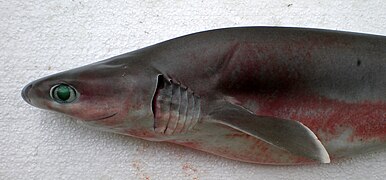Bigeyed sixgill shark
| Bigeyed sixgill shark | |
|---|---|

| |
| Scientific classification | |
| Domain: | Eukaryota |
| Kingdom: | Animalia |
| Phylum: | Chordata |
| Class: | Chondrichthyes |
| Subclass: | Elasmobranchii |
| Subdivision: | Selachimorpha |
| Order: | Hexanchiformes |
| Family: | Hexanchidae |
| Genus: | Hexanchus |
| Species: | H. nakamurai
|
| Binomial name | |
| Hexanchus nakamurai (
Teng , 1962) | |

| |
| Distribution of Hexanchus nakamurai (blue) and Hexanchus vitulus (red) | |
The bigeyed sixgill shark (Hexanchus nakamurai) is a
Measurements
Length at birth for this species is 34–45 cm; adults average 1.2 m for both genders, with a maximum of 1.8 m. Mature adults weigh around 20 kg.
Range and habitat
Bigeyed sixgills are found in the Indian Ocean and the western Pacific Ocean. Populations in the western Atlantic Ocean formerly grouped within this species are now considered their own species, the Atlantic sixgill shark (Hexanchus vitulus). These sharks live near the sea floor between 90 and 600 m deep, but may move closer to the surface at night to take advantage of prey there. They make their home on continental shelves, insular shelves, and upper slopes. These sharks do not inhabit abyssal environments.[2]
Parasites

As with other sharks, bigeyed sixgill sharks harbour a number of
Behavior
Little is known about the feeding habits of the bigeyed sixgill. Based on the few stomach examinations of these sharks, they are thought to feed mainly on small to moderately sized bony fish and bottom dwelling crustaceans. Like all sharks of the order Hexanchiformes found so far, this shark is
Conservation
The bigeyed sixgill is listed as near threatened by the IUCN Red List. Based on what little is known of the species, these sharks are not suffering major declines to their population, but pressure is growing from deepwater fisheries. According to the International Shark Attack File, the bigeyed sixgill is harmless, as its natural environment is far from people, and no attacks on humans by the species have been reported.[6]
-
Jaws
-
Upper teeth
-
Lower teeth
-
H. nakamurai, upper teeth
-
H. nakamurai, six gill openings
-
H. nakamurai, eye
-
Front part of body
See also
- List of sharks
- Hexanchidae
- Hexanchiformes
References
- ^ Finucci, B., Barnett, A., Cheok, J., Cotton, C.F., Kulka, D.W., Neat, F.C., Rigby, C.L., Tanaka, S. & Walker, T.I. 2020. Hexanchus nakamurai. The IUCN Red List of Threatened Species
- ^ Bigeyed Sixgill Sharks, Hexanchus nakamurai Archived 18 August 2013 at the Wayback Machine. marinebio.org
- ^ Euzet, L. & Maillard, C. (1974) Les Monogènes Hexabothriidae Price, 1942. Historique, systématique, phylogenèse. Bulletin du Muséum National d'Histoire Naturelle, 3° série, 206, Zoologie 136, 113-141.
- PMID 21161490.
- Fishbase
- ISBN 9780691120720
External links
- FAO Species Catalogue Volume 4 Parts 1 and 2 Sharks of the World









